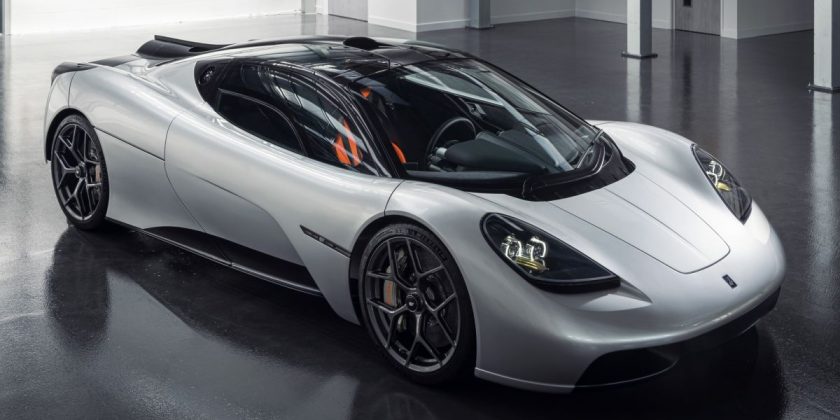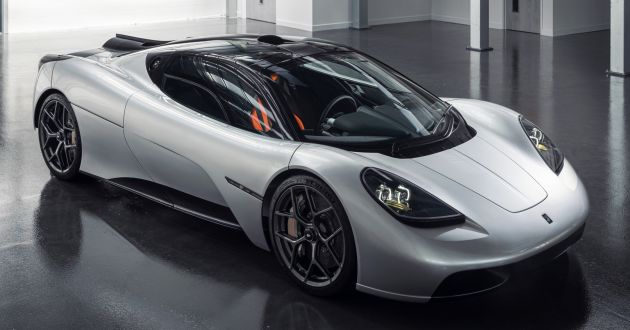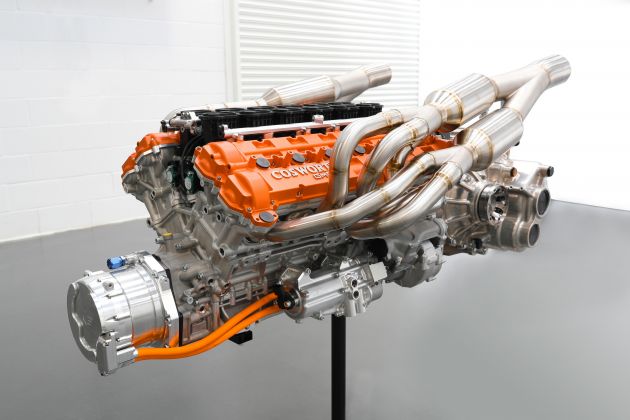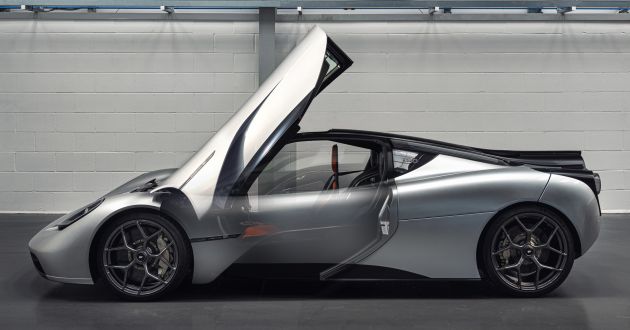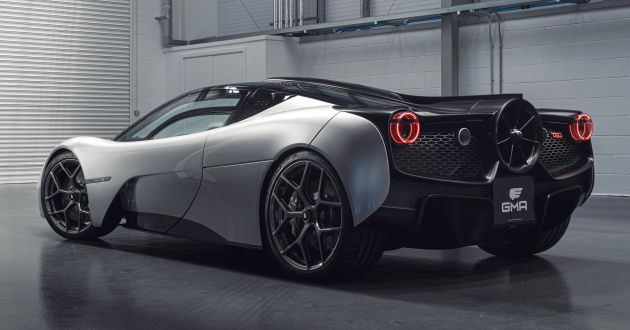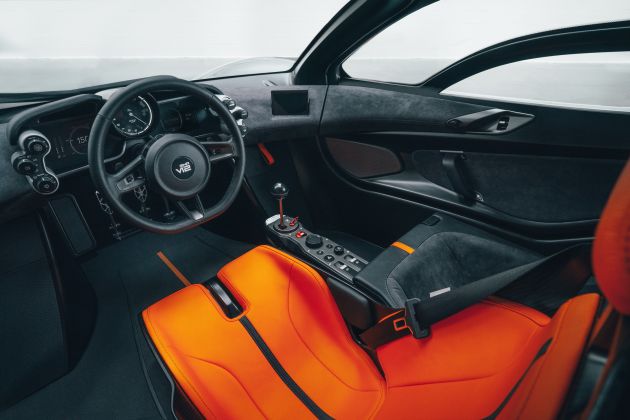Meet the new Gordon Murray Automotive T.50 supercar, or GMA T.50 for short. If you think it shares an uncanny resemblance to the legendary McLaren F1, that’s because Murray designed both cars, with the T.50 specifically aimed at being the purest, most driver-centric supercar ever built.
Murray said: “Just 100 customers will share my vision, a car created to improve on the [McLaren] F1 formula in every conceivable way. With 30 years of technological and systems advancement, now, the time is right to design the greatest analogue driver’s car. I believe no other company could deliver what we will bring to market in 2022, producing this British supercar will be my proudest moment.”
All superlatives aside, the T.50 supercar, while appearing more subdued compared to its modern peers, is actually quite the engineering marvel. Power comes from a fully bespoke 3.9 litre naturally-aspirated V12 engine that delivers a stonking 663 PS at 11,500 rpm and 467 Nm of torque at 9,000 rpm (71% of which is available from 2,500 rpm).
This Cosworth GMA engine is the highest-revving NA road car engine ever built with a ceiling of 12,100 rpm, and GMA claims that it’s the most responsive unit with 28,400 pick-up revs per second. To give you a different perspective, it takes just 0.3 seconds for the engine to hit its redline from idle.
At 178 kg, it’s also the lightest road-going V12 ever built. The block is made from high-strength aluminium alloy, while the conrods, valves and clutch housing are made from titanium. Murray also proudly stated that it’s the “best V12 sound” ever, replete with a Direct Path Induction Sound system to channel the V12 note into the cabin.
“To be truly remarkable, an engine needs to have the right characteristics: highly-responsive, an amazing sound, engaging torque delivery, free-revving, and it has to be naturally aspirated. For all those reasons, the engine in the T.50 was never going to be anything other than a V12,” Murray explained.
A lightweight 80.5 kg Xtrac H-pattern six-speed manual gearbox is standard, featuring five close ratios primed for acceleration and a longer sixth ratio for cruising. Several drive modes are available, such as GT Mode which limits revs to 9,500 rpm, while Power Mode unleashes the engine’s full breadth of capabilities.
Murray’s approach to the T.50’s vehicle dynamics is slightly different than the norm. Instead of focusing on power-to-weight, it’s flipped to weight-to-power, whereby every 100 metric horsepower has to propel 150 kg of car. The typical supercar with a comparable output has to shift at least 207 kg of weight per 100 PS, which is 40% higher.
For GMA, no amount of weight saving was too insignificant. Every nut and bolt on the T.50 was designed and engineered for the lowest possible weight, and the car’s body and chassis were constructed almost entirely from carbon-fibre.
The end result is a supercar that weighs just 986 kg, allowing GMA to use forged aluminium double-wishbones on all four corners. A car this light also sees no need for heavy electric or hydraulic suspension components. Similarly, the rack-and-pinion steering system is largely unassisted for the best possible feedback, but slight assistance is provided when parking.
The wheels, hubs, and suspension arms are all ultra-lightweight. The mixed wheels are forged from a lightweight blend of aluminium (19-inch fronts weigh 7.8 kg a piece, while the 20-inch units weigh 9.1 kg each), as are the suspension uprights. A single locking nut is employed, because less is more.
Michelin Pilot Sport 4 S rubbers are standard here, and these tyres are narrower (235/35 R19 front, 295/30 R20 rear) than comparable rivals. Braking is provided by Brembo’s latest-generation six-piston Monobloc calipers up front and four-piston Monobloc units at the back. These clamp on to carbon ceramic discs (front 370 mm x 34 mm/rear 340 mm x 34 mm) that have been tuned to provide low levels of servo assistance, making heel-and-toe gear changes feel easy and natural.
Now, the car’s actual design is a breath of fresh air, with Murray favouring simple, timeless lines and clean surfaces. But don’t let this fool you, because while it does not rely on wings, vents, or ducts to emphasise its performance capabilities, the T.50 features a rear-mounted 400 mm fan and six aerodynamic profiles. Of course, it had to be branded as the most advanced aero system on a road car.
The 400 mm fan is something you don’t see everyday, but few realise that the McLaren F1 had two smaller fans hidden beneath its haunches to pull air below the car. On the T.50, it’s functionally the same, and works by actively managing underbody and overbody airflow, thereby balancing drag and downforce at all speeds.
Not only that, the 400 mm fan interacts with a pair of active spoilers at the rear, providing more downforce as the car deems necessary. Powering the fan is a lightweight 48-volt motor which spins up to 7,000 rpm. GMA incorporated filters into the vertical inlet ducts to ensure no debris gets in the way of the fan. Are you a fan of the design, though?
Besides that, the T.50 gets LED headlights with integrated heat sinks at the top and bottom of each unit, roof-mounted ram-air induction, and glass-topped dihedral doors that hinge along the spine of the car to reveal the engine cam covers. There’s no engine covers because Murray, in his own words, detests them. This configuration also allows for a more convenient access to regular maintenance.
While the T.50 may appear to be a single seater race car, it’s actually a three-seater – the driver sits in the middle, while the two passenger seats are recessed on the left and right side. Each customer will have a customised seat fitting during the build process, where GMA will adjust the steering wheel height and reach, as well as fine tuning the pedal box setup for the most precise fit. It doesn’t get more bespoke than this, guys.
To the right of the driver is a “floating” titanium gearstick that sits on an arm, revealing the titanium gearchange mechanism on its bare underside. Other nifty touches include a centrally-positioned start-stop button (sheathed beneath an anodised red switch cover), laser-etched chassis plate denoting the build number, and three-spoke carbon-fibre steering wheel.
The driver gets a 120 mm analogue rev counter with a needle milled from aluminium, and if you haven’t noticed, there’s no touchscreen displays or stalk controls – the indicators are operated by thumb-buttons. The three seats, which are made from carbon-fibre, have a combined weight of just 13 kg. Let that sink in.
There is, however, a tiny head unit on the right side of the dashboard. This is paired with a bespoke 700-watt, 10-speaker Arcam sound system. The whole system weighs just 3.9 kg and features wireless Apple CarPlay, Android Auto, and GPS navigation functions.
It’s hard not to be interested in the GMA T.50 after going through the details above, so if you really want one, you’ll have to cough up at least £2.36 million (RM13 million). Only 100 units will ever be made, and each customer will get the chance to meet with Murray during the fitting session. Customers in the UK, US, Japan and Abu Dhabi will have access to appointed service centres, while a ‘flying technician’ will support other markets.
Source: Read Full Article
